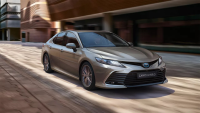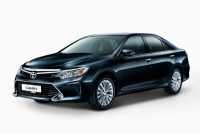The 2005 Toyota Camry passenger car has undergone a number of changes aimed at improving consumer characteristics. The cars were supplied to different markets and differed in the location of the steering wheel and the list of available options. Modernized sedan XV30 was produced until the end of December 2005, after which it was replaced by a new generation XV40.
Car appearance 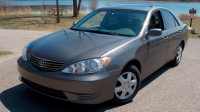 The 2005 model year cars have undergone a slight restyling, which affected the appearance. Revisions touched the interior details, as well as the powertrain. The general appearance of the body remained unchanged: the manufacturer offered only 4-door sedans. Japanese models differed by trim elements, and North American versions have original lighting equipment in accordance with local regulations.
The 2005 model year cars have undergone a slight restyling, which affected the appearance. Revisions touched the interior details, as well as the powertrain. The general appearance of the body remained unchanged: the manufacturer offered only 4-door sedans. Japanese models differed by trim elements, and North American versions have original lighting equipment in accordance with local regulations.
Car Exterior
Externally upgraded cars can be distinguished by the radiator grille, which received three transverse chrome fins. Manufacturer's emblem has been lowered relative to the hood's edge. Headlights have a modified configuration with separate lamps and reflectors for low and high beam. Turn signals were equipped with orange plastic diffusers. The front fender was not available in 2005.
The fog lights in the front bumper have a different configuration. The rear lighting system has undergone changes: the elements have retained their outlines and dimensions, but they are located differently.
For example, the section of the brake lights is installed in the center of the spotlight. The manufacturer began using aluminum alloy rims with a modified design and a central cover with the concern's emblem (radius R16).
The range of colors was preserved: base - white paint, there were materials with metallic effect. Side glazing has a protective green coating, which prevents heat loss. Rubber moldings were used on the side door surfaces to protect them from damage. All exterior plastic body parts were painted in the base color (mirror housings, door handles and decorative trim).
Interior 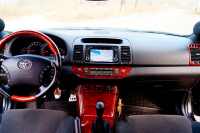 The car is equipped with a new Optitron combination of devices, distinguished by the increased brightness of indicators. The upper part of the instrument panel is made of soft polyurethane. The ventilation ducts are equipped with air direction controllers and flow shut-off shields. The top of the center console, the framing around the climate control and the lining on the door cards have a special coating that imitates a veneer of natural wood. On the steering wheel appeared blocks of buttons to control the radio (were put on some cars).
The car is equipped with a new Optitron combination of devices, distinguished by the increased brightness of indicators. The upper part of the instrument panel is made of soft polyurethane. The ventilation ducts are equipped with air direction controllers and flow shut-off shields. The top of the center console, the framing around the climate control and the lining on the door cards have a special coating that imitates a veneer of natural wood. On the steering wheel appeared blocks of buttons to control the radio (were put on some cars).
Speakers of the speaker system are located in the front doors and the shelf behind the rear sofa. A CD player was included as standard equipment. Some trucks used navigation and a rear-view camera with dynamic lane marking.
Seat trim material depended on the market (for example, Japan and the United States offered velour or leather, while Europe sold cars with thick fabric covers).
Luggage compartment - with a hinged floor, under which there is a spare tire and a set of factory tools. Rigging nets were provided to hold cargo. A hinged backrest allowed long objects to be carried. A cargo light was switched on when the cover was unlocked.
Technical Specifications
The 2005 model year Camry trucks retained the transverse arrangement of the power plant. A disc-type braking system with a hydraulic actuator divided into two diagonal circuits is used. The steering system uses a rack and pinion steering system with a hydraulic booster. The paddle pump is located on the cylinder block and is driven by a pulley on the toe of the crankshaft. The engine power system has an electric high-pressure pump located inside a 70-liter tank. The tank is fixed in the body recess under the rear seat.
Engine displacement
The 2-liter power unit is no longer used. The range still included 2AZ-FE and 1MZ-FE gasoline engines with Distributed Injection, which had 2.4 and 3.0L displacements, respectively. In the U.S. the 3.3 L engine was available, which differed from the 1MZ-FE with a larger bore and a reduced stroke.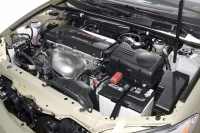 Engine and transmission
Engine and transmission
The European market offered cars with gasoline engines:
2AZ-FE inline four-cylinder with variable valve timing system, which developed 152 hp;
V-twin 6-cylinder 1MZ-FE.
The 2.4-liter engine was offered with a 5-speed manual transmission or 4-speed automatic transmission with a hydraulic transformer. The version with the powerful engine was accompanied by an upgraded 5-speed automatic transmission. Only the 159-horsepower 2AZ-FE engine with automatic transmission (4-speed) was available on the Japanese market. In addition to the front-wheel drive version, there was a version with a viscous clutch and 4x4 drive (with electronic distribution of torque depending on road conditions).
American cars had 160 and 210 hp engines (with 2.4-liter and 3.0-liter displacement, respectively). In California, the 151-horsepower 2AZ-FE with natural gas injection system was offered. The tank is located in the spare tire recess. A tire repair kit was included. A limited version with 3MZ-FE engine was available for the USA, which developed 225 hp and 3.3 liters (came only with a 5-speed automatic transmission).
Chassis
The suspension concept is the same as the original independent lever-arm suspension with anti-roll bars. The front and rear axles are McPherson-type hydraulic struts and cylindrical springs with non-linear stiffness characteristic (some parts are different from those installed in the early Camry). The arms have rubber-metal joints for attaching to hubs and welded subframes. At the rear, space is provided for mounting a gearbox and half axles (only on the Camry Four for Japan).
Fuel consumption rate
The claimed average fuel consumption in the urban cycle for the 2.4-liter engine is 11.7 liters per 100 kilometers. On a highway the car meets the passport 6,9 liters only with a partially loaded saloon (a driver and a passenger), driving up to 100 km/h and usage of inertial drive. The model with a 3-liter engine consumes not less than 16 liters of A-95 gasoline in the city. On the highway the parameter does not fall below 8.5 liters. Because of the wear of piston group and neutralizer the costs increase by 1-5 liters per 100 kilometers.
Gas American version had reduced to 9.8 liters per 100 kilometers and meets Californian environmental standards SULEV. On a highway, the engine needed 6.9 liters of fuel. The model with a 3.3-liter engine due to the excess power has a reduced consumption. In a city traffic the car needs 11.8 liters on average, and on the highway at 100-120 km/h fuel consumption drops to 8.1 liters per 100 kilometers.
Pros and cons of the 2005 Camry
Advantages of cars noted by owners in reviews:
good acceleration dynamics of versions with a 3-liter engine;
high reliability of the chassis elements;
prevalence of original spare parts;
the ability to use parts removed from wrecked cars;
good directional stability due to the long base and heavy weight;
fast start-up at ambient temperatures from -30°C;
simple design, allowing self-service and repair;
large volume of luggage compartment (520 liters).
Disadvantages of the machines:
low ground clearance;
swaying when driving over longitudinal roughness;
body tilt when turning;
high fuel consumption in the city (compared with vehicles produced after 2010);
insufficient noise insulation of the engine shield and wheel arches;
some machines use the outdated 4-speed automatic transmission;
complicated algorithm of replacement of timing chain drive.
Test drive results
Test drives of the 2005 Toyota Camry sedan model year were conducted by both car magazines and private experts. The reviews noted that the car retained the high quality of interior decoration, but the design was considered boring and monotonous. Seat adjustments are sufficient for tall people, the steering column is adjustable in height and angle of installation. All buttons and levers are located at arm's length. View from the driver's seat is partially limited by the thick roof pillars.
The version with a 3-liter motor is characterized by good dynamics, the electronic system did not allow the wheels to slip when starting abruptly. The automatic transmission has an overdrive gear and a control unit that adapts to the specifics of driving. Modifications with 2.4-liter unit were criticized for not enough intensive acceleration, but no problems with the automatic transmission (4 steps). The driver and passengers did not feel the moments of shifting, and during quiet acceleration the engine did not enter the zone of high revolutions.
Power-assisted steering provided good maneuverability in cramped conditions, but as the speed increased, the testers noted a loss of sensitivity.
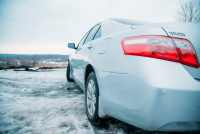
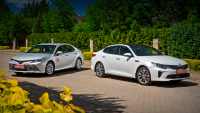
-rear-and-front-view-camera-6.png)
